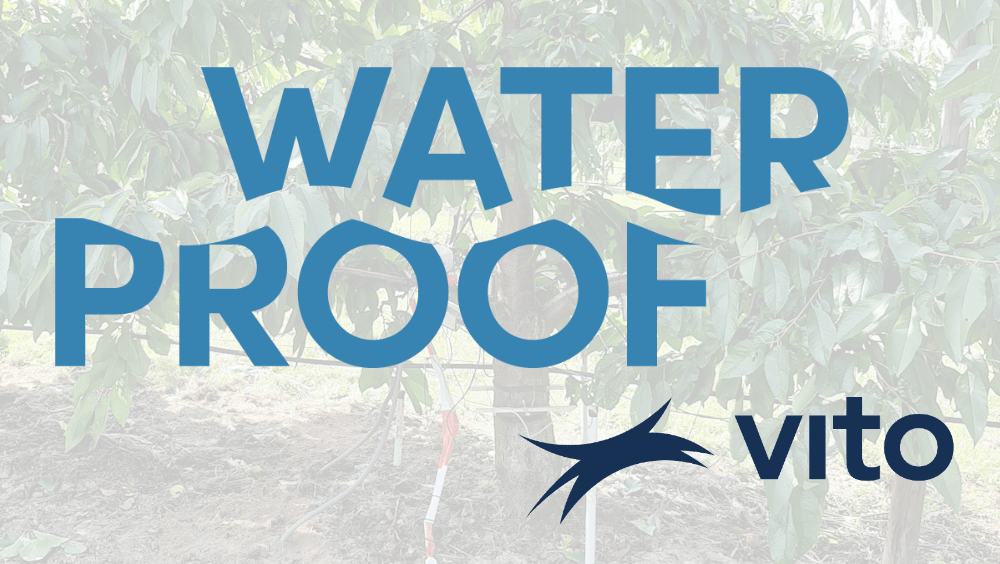How VITO makes Flanders waterproof

Are you already familiar with the Flemish Blue Deal? This ambitious project combats water scarcity and drought. It focuses on cooperation and implements concrete measures, such as smart water use, wet nature restoration, and green-blue infrastructure.
Mentality change, innovation and policy measures are included in the approach. By retaining water locally, reusing it and reducing waste, the Blue Deal seeks to create a balance between water supply and demand. The project stimulates cooperation between companies, farmers, citizens and knowledge institutions, focusing on concrete, practical solutions. One of these knowledge institutions is VITO (Flemish Institute for Technological Research), which is in charge of the Flanders WaterProof project within the Blue Deal.
In practice innovation and realisations rely on thorough research and concrete data. This is why the actions in the context of Flanders WaterProof are monitored and logged with great precision.
Flanders WaterProof
Water scarcity and flooding are very relevant challenges, especially for Flanders. In Flanders WaterProof, an emphasis is put on better retention and use of (rain) water instead of rapid discharge towards the sea.
In concrete terms, the project studies sustainable, systemic solutions in three demo areas: an industrial zone in Tielt, the sand extraction wells in the Kempen region and the fruit regions Haspengouw and Hageland. The focus is put on sustainable measures that make the area and the local economy resistant to climate change, not merely symptom control.
This obviously requires the necessary knowledge and expertise.
As a knowledge institution with the mission to accelerate the transition to a sustainable world, VITO coordinates the project. Additionally, Flanders WaterProof combines the strength and expertise of several strong partners and stakeholders. They each make a meaningful contribution in their domain or region to the success of the project and the transition to a resilient Flemish water system.
Water-related challenges
Of all European regions, Flanders ranks high in terms of water scarcity and drought risks. That has several causes.
Many people who live in a small area combined with water-intensive sectors in agriculture and industry lead to high water consumption. When it rains today, however, most of the water enters the sewers and disappears into the sea.
As a result of the high level of urbanisation in Flanders, rainwater cannot sufficiently seep into the soil. As a result, our groundwater reserves are diminishing. The high degree of paving, on the other hand, ensures that the water quickly heads towards the sewers and then ditches, rivers and canals and flows away towards the sea. During heavy rain, this increases the risk of flooding as the sewers or nearby waterways can no longer deal with the volume of water. Canals and drainage pipes also encourage rapid water discharge.
Climate change causes longer periods of drought, alternating with heavy rainfall. As a result, rainwater will have an even harder time seeping into the dry soil, which simultaneously increases the risk of severe flooding significantly.
Water savings
To tackle the aforementioned issues, VITO works on ingenious solutions to better retain and beneficially reuse rainwater. This is done together with various partners within Flanders WaterProof. To achieve this, physical installations were installed at test sites. This allows real data to be collected and evaluated and the measures to be demonstrated at the same time.
In the projects below, VITO used Reporter with a variety of sensors to accurately measure the test set-ups.
Haspengouw and Hageland is one such demonstration where VITO, in close cooperation with the Research Centre for Fruit Growing (pcfruit) and farmers, is looking for ways to make fruit growing resistant to the changing climate.
Robust management of soil and water with the goal of water gain is what they are aiming for here.
Flanders WaterProof for the fruit region
Trials are being carried out at several locations in the fruit region. These include testing measures to reduce runoff on sloping fields and studying how smart irrigation can reduce water consumption without yield loss.

The sloping pear field
During heavy downpours, a lot of rainwater is lost on (slightly) sloping fields. For this reason, VITO, in collaboration with pcfruit, investigated exactly how much water is lost and how this 'lost water' (runoff) can be collected and reused.
For this purpose, grids were dug into the bottom of two grass strips where the runoff rainwater collects (left in the photo above). Through a system of pipes and thanks to gravity, this water flows through to reservoirs (right in the photo above) where the water level is measured. Meanwhile, the weather station next to the reservoirs monitors weather conditions and measures precipitation. This allows real-time monitoring of the impact of precipitation on the water level in the reservoirs and calculation of runoff.
More information on this trial can be found in this article: How to increase water infiltration on sloping fruit plots? (Dutch only).

Smart irrigation
Orchards need water to deliver good yields. The exact water needs for irrigation, however, are difficult to determine without using an accurate monitoring system with the necessary sensors (soil moisture, stem thickness, etc.). The photos above show a dendrometer trial setup for stem thickness measurement (left) and a soil moisture measurement trial setup with Watermark sensors (right).
In an effort to transition to more sustainable irrigation methods, VITO and pcfruit are conducting a trial in which the stem thickness of pear trees is measured using dendrometers to track the water requirements of the vegetation.
"At night, the trunk expands as trees absorb maximum moisture through the roots. During the day, the trees shrink. The rate at which they shrink is therefore an indicator of how much moisture a tree absorbs. Do they absorb enough moisture or do they enter a state of stress due to lack of moisture? If the trunk increases less at night than it shrinks during the day, the tree is clearly thirsty." - Flanders WaterProof, efficient water use
The farmer compares this dendrometer data with measurements from soil moisture sensors. This makes it possible to assess more accurately whether irrigation is required already and how much water needs to be given to meet the needs of the crop. This guarantees sustainable water use.
From measurement to action: automated irrigation with Reporter
As part of the Vlaanderen WaterProof project, Reporter was deployed as a component in a fully automated irrigation system. Enginity acted as the system integrator for this project, ensuring that sensor data was not only logged, but also used to trigger immediate actions in the field.
The company developed the software layer that communicates with the Crodeon API, automating the daily data cycle and ensuring seamless interaction between all systems — from sensors to model and actuators.
Smart data flow and control
Each evening, the irrigation data was summarised. These results were sent by Enginity’s software to a server running the irrigation advisory model at the Research Centre for Vegetable Cultivation. Based on the real-time data, the model could then create the plan for the following day.
Every morning, Enginity’s software reset the irrigation counters and automatically opened the valves. During the day, the system compared the actual irrigation levels with the maximum amounts calculated by the irrigation model from the Research Centre. As soon as a zone reached its limit, a signal was sent to close the corresponding valve.
Reliability and impact
Thanks to automatic fault detection via email alerts, the system remained transparent and manageable, even in the event of malfunctions. The result? Fewer labour hours, more efficient water use, and a data-driven irrigation process that perfectly aligns with the needs of both the crop and the climate.
Crodeon's contribution to Smart Agriculture
VITO uses Reporter in combination with weather sensors, level sensors, soil moisture sensors and dendrometers to measure and log the aforementioned projects. Reporter's reliable GSM connection and data streaming to the cloud allow researchers unimpeded data collection with the assurance that everything is stored online.

We are proud to support research on Smart Agriculture and sustainable water use together with VITO and we thank them for their trust in Reporter.
Are you looking for a reliable sensor module for remote monitoring and data logging for your farm or agricultural research project? Be sure to contact us!








